Traditional Braces – Parsippany, NJ
Providing Trusted Orthodontic Care in Parsippany
Braces are a wonderful way to enhance the appearance of your smile while also improving your oral and overall health. People of all ages can benefit from a properly-aligned smile, and your orthodontist in Parsippany can help you or your child achieve it with traditional orthodontics. Whether it is crooked teeth, overcrowding, gaps between teeth, or a bite alignment issue, regular braces are a tried-and-true solution to help patients see results that will last a lifetime. Keep reading to learn more about how traditional braces in our Parsippany, NJ dental office work and how you can schedule a virtual consultation with Dr. Kitay today.
How Do Traditional Braces Work?
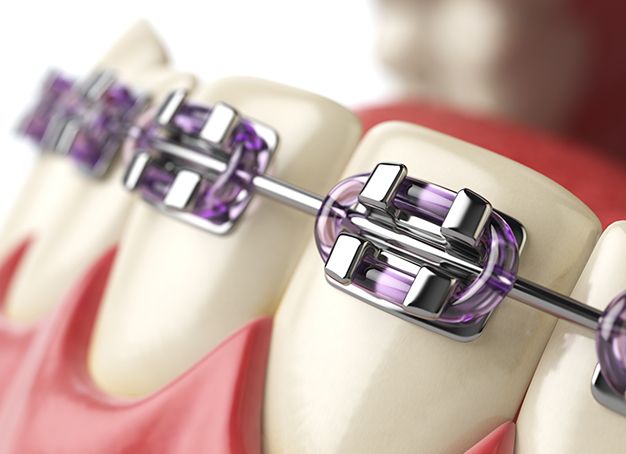
Traditional braces are metal brackets that are fixed to the front surface of the teeth. A wire is threaded through each bracket and tightened at various intervals throughout the treatment. By manipulating the wire, your orthodontist is able to place pressure on different areas of the bite to gradually bring the teeth into the proper position.
Traditional braces work in two stages: first, the tooth is moved, and then its root moves along to catch up. The total treatment time for traditional braces depends on the complexity of the case -- most patients are finished with braces between 18 and 24 months.
Traditional Orthodontics for Children and Teens

If your child or teenager undergoes regular treatment with Dr. Rauchberg, he and our team will be able to monitor their smile as it develops over time. While it is our goal to detect problems early on and attempt to curb the effects, there are still instances that permanent teeth will not erupt as they should, which will ultimately mean a need for orthodontic treatment.
When this happens, we will work closely with you and your child to determine the right method of treatment to realign their teeth and bite and give them a healthier, more beautiful smile they can feel good about well into the future.
Traditional Orthodontics for Adults

When it comes to wanting to improve your smile, anyone who could benefit from orthodontic treatment can choose traditional braces, no matter the age. Some ways to tell if your teeth are out of alignment include:
- An aching jaw or chronic headaches
- Evidence of nighttime teeth grinding or jaw clenching
- Visibly misaligned teeth
- Tartar buildup between crowded teeth
- Frequently getting food lodged between certain teeth
- Soft tissue injuries due to teeth that jut out or are crooked
The only way to know for sure whether or not you can benefit from traditional braces, Invisalign, or tooth-colored braces is to schedule an appointment with Dr. Kitay, our in-house orthodontist, to discuss braces in Parsippany.
Caring for Traditional Braces
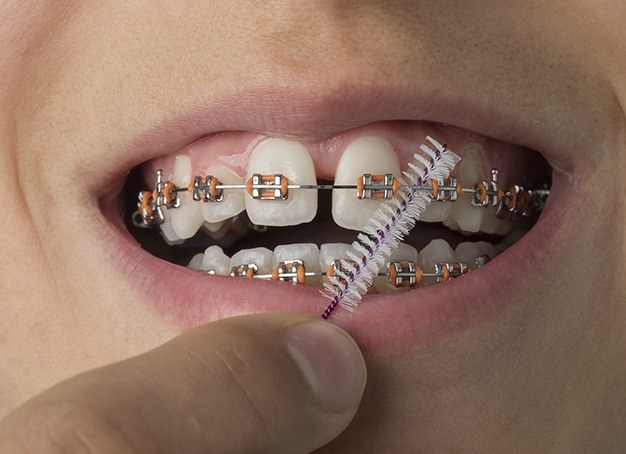
Apart from making sure you attend your regular appointments with Dr. Kitay throughout treatment, you should be sure to also do the following:
- Brush regularly. You’ll need to use a soft-bristled toothbrush and tilt it at a 45-degree angle to get around the gum line, brackets, and along the chewing surfaces and backsides of your teeth. It is also helpful to invest in an interdental brush to get the sides of your brackets and underneath the wire.
- Floss. Because food particles and bacteria can become trapped between your teeth, you may need to purchase a dental flosser or water irrigator to make flossing easier. These devices make it more manageable when attempting to get underneath the wire and between your teeth. This continued practice will keep your teeth free of decay and gum disease while wearing braces.
-
Avoid certain foods. Although you may not want to, you should steer clear of any hard, crunchy, or chewy foods, as they can not only damage your natural teeth but also potentially cause a wire to pop out or bracket to come off. While wearing braces, stay away from:
- Popcorn
- Dried fruit
- Gum
- Candy
- Corn on the cob
Understanding the Cost of Traditional Braces
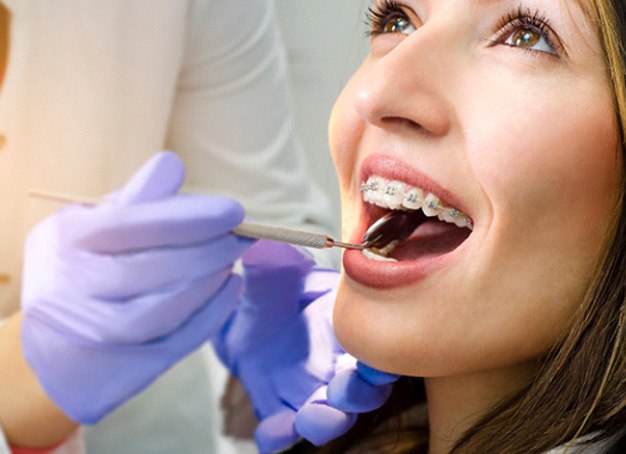
There is no set price when it comes to determining the cost of traditional braces. Each patient is different, so a full consultation is required to create a complete cost estimate for treatment. A unique set of variables must be established to develop the framework for your orthodontic plan, which will then serve to provide a clearer discussion regarding the expected costs.
Factors That Affect the Cost of Traditional Braces
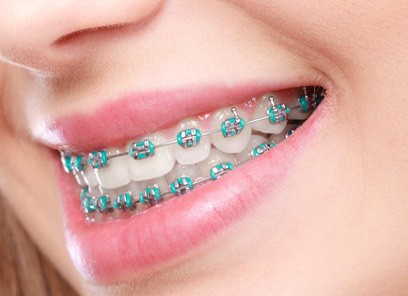
When meeting with our in-house orthodontist, Dr. Kitay, we will base the cost of your care on the following factors:
- Severity of misalignment – When teeth require greater distances to shift, you can expect treatment to take much longer.
- Length of your treatment – If it is estimated that you will require braces longer than “average,” the cost will be much higher. This is due to the additional follow-ups, adjustments, and supplies needed.
- Age – Adults who require braces may experience higher costs because teeth are already set in the jawbone, requiring more time for teeth to move.
- Number of follow-up appointments – It’s necessary for braces to need adjustments and wire tightening every 2-8 weeks, which can increase the cost.
- Additional orthodontic devices or appliances needed – It’s not uncommon for most patients with braces to require additional appliances such as palate expanders, elastics, headgear, and retainers.
- Compliance with treatment – If you adhere to the treatment guidelines provided by our team, you can expect your teeth to move correctly and keep your timeline for completion on track. If you do not, you will spend more time in braces, thus, increasing the cost.
Professional Braces vs. “DIY” Braces: Which Costs More?
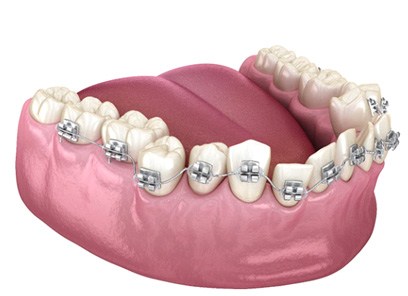
You may be surprised to learn that do-it-yourself (DIY) orthodontic solutions are becoming more popular among individuals who want to avoid the high price of traditional braces. Unfortunately, using items such as rubber bands, dental floss, hair elastics, paper clips, fishing lines, dental wax, and even superglue can cause significant damage to your smile.
Although you may be enticed by the money you’ll save, you may face one or more of the following consequences:
- DIY solutions do not offer permanent results, as they are often ineffective long-term. This means your teeth will shift back into their original position.
- Attempting homemade braces can damage your teeth, gums, and jaw. Because most of the materials used to create these DIY solutions are not professional-grade or orthodontist-approved, they can cut into your gums, cause an infection, and create sores. The results can be disastrous, even causing you to lose one or more teeth.
- DIY orthodontics lacks the necessary oversight by a qualified professional, which means that your teeth may not shift in the direction you want them to. If your jaws don’t properly align, you could end up with chronic pain and severe damage.
- You may think that you’re saving money with a DIY solution, but the reality is that once you see the lackluster results, you’ll end up spending even more financially because of the necessary appointment you’ll need to make with an actual orthodontist.
Does Dental Insurance Cover Traditional Braces?
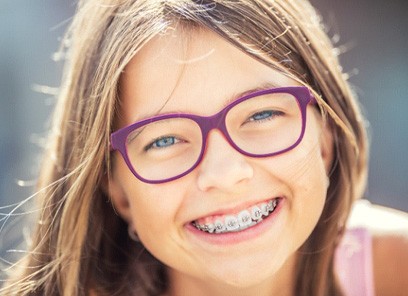
You will need to review your dental insurance plan to determine if orthodontics is covered. While some policies offer it, others do not, which means you will need to either purchase an additional plan or use a Health Savings Plan (HSA) or Flexible Spending Account (FSA) to cover the cost. It is possible that if your dental insurance company does offer coverage, they will agree to pay up to 50% of the total cost, but you need to be mindful of any exclusions or special coverage that may only be available to patients under the age of 18.
Options for Making Traditional Braces Affordable

Typically, traditional braces can cost anywhere between $4,000 and $7,000, and if you don’t have dental insurance that can help to cover a portion of the cost, you may be wondering if there are any alternative ways to save. Fortunately, at Rauchberg Dental Group, we are pleased to offer:
- Flexible financing through CareCredit, which allows you to enroll in a low-to-no-interest payment plan with no surprise fees.
- An in-house membership plan that allows you to pay a flat fee for access to complimentary dental checkups and cleanings and valuable discounts on other available services. You can avoid high deductibles, waiting periods, and yearly maximums.
Traditional Braces FAQs
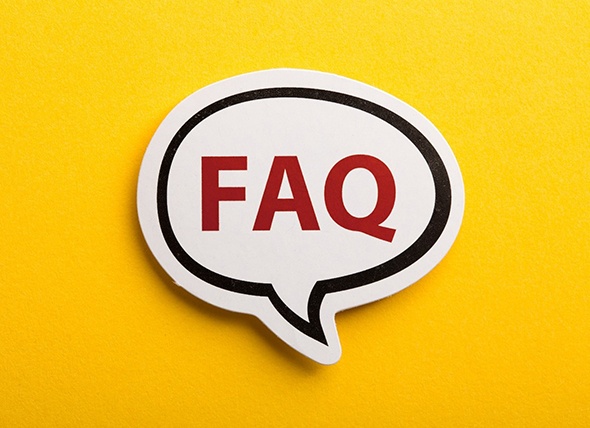
Want to know more about traditional braces in Parsippany before taking the plunge? Our knowledgeable team has collected some of the most common questions about braces and answered them below. We hope you find these FAQs informative and helpful. For more information about orthodontic treatment or to schedule a consultation, don’t hesitate to contact our office.
How Long Do Traditional Braces Take?
While every smile is different, traditional braces usually take somewhere between one and three years to fully straighten teeth. Some of the factors that affect how long traditional braces take include:
- Age – Adults’ teeth are more firmly set in the jawbone than those of children and teenagers, so straightening them will take longer.
- Severity of alignment issues – Orthodontic treatment generally takes longer the greater the distance that teeth need to move.
- Compliance with treatment guidelines – If, for example, you need to wear rubber bands on your braces, but you fail to do so often enough, your teeth won’t move as planned. Therefore, your treatment will probably take longer.
The exact length of time for orthodontic treatment can vary greatly between patients. After examining your teeth and discussing your smile goals, Dr. Kitay, our in-house orthodontist, will provide you with an estimated timeline.
Can I Get Traditional Braces on Just My Top or Bottom Teeth?
If you’re unhappy with only one dental arch, you may be tempted to get braces on just your upper or lower teeth. While this approach may seem more convenient and cost-effective, it’s almost never recommended. Traditional braces are designed to bring both arches into alignment. Shifting one and not the other could actually cause more harm than good. If you have crowded teeth, for example, braces will likely straighten your teeth my shifting them forward. Likewise, closing gapped teeth will often cause the teeth to move backward. Adjusting one arch of teeth and not the other will typically prevent them from coming together properly, which could lead to difficulty chewing, TMJ disorder, teeth grinding, and other problems.
Can I Chew Gum with Traditional Braces?
Chewing sugar-free gum has been proven to lower the risk of decay if chewed for 20 minutes after eating by stimulating saliva production. However, this benefit may be outweighed by the risk of damaging your braces. Chewing gum and other sticky substances (e.g., taffy, caramel, etc.) can get stuck in your braces and end up bending the wires. This type of damage to your braces could cause your teeth to shift in unexpected directions without your even realizing it, and ultimately prolong the length of your treatment. So, while chewing gum is fun and may even be good for your oral health, it’s probably not worth the risk while undergoing traditional orthodontic treatment.
Do Traditional Braces Cost More Than Invisalign?
In most cases, the cost of traditional braces in Parsippany is comparable to the cost of Invisalign. You can expect to pay somewhere between $1,800 and $5,500 for metal braces, while Invisalign usually costs anywhere between $3,000 to $5,000. While many dental insurance plans include traditional orthodontic coverage, fewer cover the cost of Invisalign. In addition, one key difference between metal braces and Invisalign is that you could accidentally lose or damage an invisible aligner. This could result in higher costs and delay your treatment. You don’t need to worry about that with traditional braces since they’re fixed on your teeth. If you’re a candidate for both Invisalign and traditional braces, your orthodontist will compare the costs and help you decide which option would be best for you.
